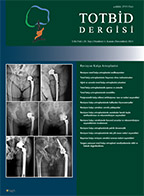
Total hip arthroplasty (THA) is one of the most successful surgical procedures performed in the last 25 years. Due to the increasing number of THA surgeries, there has been a significant increase in revision hip arthroplasty surgery, especially in the last 10 years. The number of revision hip arthroplasty is expected to increase at least twice in the next 10 years due to the longer and higher quality life expectancy of the patients and the increasing prevalence of THA applications to younger patients. Understanding the causes of failure is important for research, clinical decision making, and guiding health care policy. In a patient with symptomatic THA, the source of pain should be approached systematically and comprehensively. A detailed history and physical examination can usually make the correct diagnosis. On physical examination, both hips, knees, and spine should be evaluated. Serological testing for infection should be performed with joint arthrocentesis and standard radiographs if necessary. Computed tomography (CT) is particularly useful in evaluating implant position, bone loss, osteolysis, insert wear, and metallosis. Magnetic resonance imaging (MRI) is suitable for evaluating soft tissues. A nuclear medicine scan such as Tc-99 m may show false positives up to the second postoperative year but can be combined with an In-111 leukocyte scan to differentiate between infection and aseptic loosening or stress fracture. Surgery should not be performed without preoperative diagnosis.